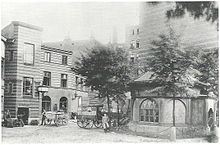Luisenhaus (Berlin)
| Luisenhaus | |
|---|---|
 Luisenhaus Badstrasse |
|
| Data | |
| place | Berlin-Gesundbrunnen |
| builder | Carl Galuschki (master carpenter) |
| Client | Carl Galuschki |
| Construction year | 1892-1893 |
| Coordinates | 52 ° 33 '11.9 " N , 13 ° 22' 42.8" E |
| particularities | |
| Relief with the inscription "In fonte salus" ('Salvation is in the spring') |
|
The Luisenhaus is a listed residential and commercial building at the west end of Badstrasse in the Gesundbrunnen district of Berlin and part of the “Zentrum Gesundbrunnen” monument area.
history

At the end of the 19th century, only the fountain house and the “Traiteurshaus” restaurant Luisenbad on the Panke were left of the former facilities of the Luisenbad , which now protruded far beyond the new building line. When the carpenter Carl Galuschki wanted to build the representative "Luisenhaus" in 1891, these two buildings had to give way to the new building. Galuschki, who had owned the Marien- and Luisenbad since 1885, decided to rebuild it in the Marienbad park due to the historical importance of the fountain house, but the restaurant was demolished and the spring itself was moved into the garden through a thin pipe.
The six-storey building mainly contained apartments, while business and sales rooms were built on the ground floor, which were used by the traditional "Cafe Jahn" until the 1980s. The mineral water company "Königin Luise-Quelle" operated a bottling plant for artificial mineral water in the Comtoir building behind the Luisenhaus . It is no longer possible to determine whether the water from the spring was actually bottled or only its name was used.
In 1907/1908, at Galuschki's suggestion, Travemünder Strasse was built between Bad and Osloer Strasse on the banks of the Panke . Galuschki was compensated by the city with 633,314 marks (purchasing power adjusted in today's currency: around 3,857,000 euros) for the ceded area . However, the planning dragged on for a very long time, so that Galuschki did not receive the proceeds from the sale of the road land to the city that he had hoped for. The well house, which in turn stood in the way of the road construction, was demolished on March 14, 1908, Galuschki was no longer financially able to save it because he had speculated. One third of the Luisenhaus, built in 1891, was demolished and a new facade was built between 1906 and 1907 on the side facing the Panke. On the upper part of the facade, a relief of the well house with the inscription "In fonte salus" ('In the spring is salvation') reminds of the past of the Gesundbrunnen. The former well of the dried up spring was still in the basement of the Luisenhaus until the middle of the 20th century, but was concreted over in 1964.
Heavily indebted and persecuted by his creditors, Galuschki shot himself on December 31, 1910 at the gates of the Dalldorf insane asylum after he had not been admitted there. He had his legacy to posterity welded into the tower head of the house: his curriculum vitae and the chronicle of the Gesundbrunnen by Otto Suchsdorf .
architecture
With its idiosyncratic, elaborate, multi-colored decoration, the Luisenhaus dominates the surrounding street space. Galuschki clad the building with red, white, yellow and green bricks , which are put together to form geometric ornaments and friezes . The lively play of shapes and colors changes from floor to floor. Gable axes with curved arched gables are formed over the protruding bay windows . The two top floors are combined by pilasters . The corner tower was not preserved. The highlighted wall axis of the side front, which was never completed, refers to the history of the Gesundbrunnen. In the gable field you can see a relief of the fountain house built in this form in 1809. Originally, sculptures of Kings Friedrich I , who is said to have discovered the mineral spring, Friedrich II and Queen Luise were to be placed on the three consoles .
literature
- Matthias Donath, Gabriele Schulz: District middle districts Wedding and Gesundbrunnen . Ed .: Landesdenkmalamt Berlin (= monument topography Federal Republic of Germany. Monuments in Berlin ). Michael Imhof Verlag, Petersberg 2004, ISBN 3-937251-26-X , p. 123 .
- Christine von Oertzen: Boulevard Badstrasse . Big city history in the north of Berlin. Ed .: District Office Wedding of Berlin. Edition Hentrich, Berlin 1993, ISBN 978-3-89468-081-7 , pp. 38 ff .
Web links
- Entry in the Berlin State Monument List
- Luisenhaus. In: District lexicon of the Luisenstädtischer Bildungsverein . Retrieved October 13, 2016 .


